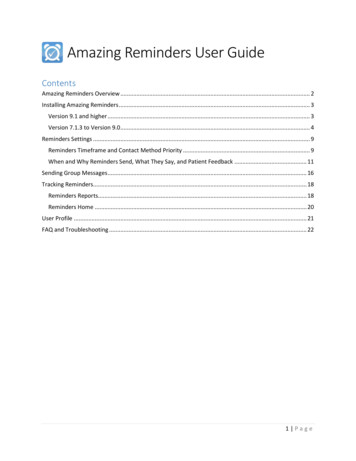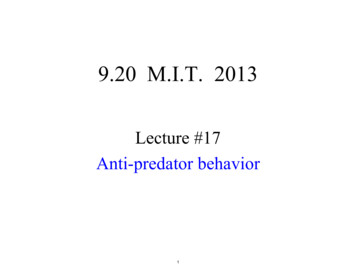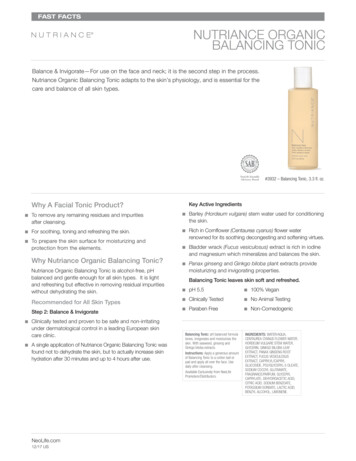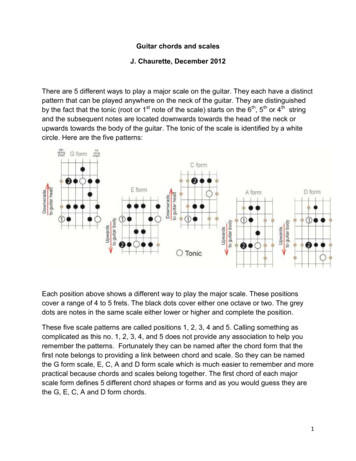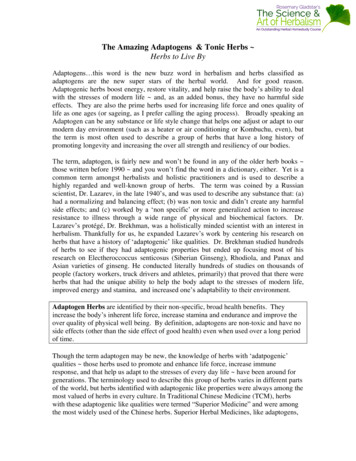
Transcription
The Amazing Adaptogens & Tonic Herbs Herbs to Live ByAdaptogens this word is the new buzz word in herbalism and herbs classified asadaptogens are the new super stars of the herbal world. And for good reason.Adaptogenic herbs boost energy, restore vitality, and help raise the body’s ability to dealwith the stresses of modern life and, as an added bonus, they have no harmful sideeffects. They are also the prime herbs used for increasing life force and ones quality oflife as one ages (or sageing, as I prefer calling the aging process). Broadly speaking anAdaptogen can be any substance or life style change that helps one adjust or adapt to ourmodern day environment (such as a heater or air conditioning or Kombuchu, even), butthe term is most often used to describe a group of herbs that have a long history ofpromoting longevity and increasing the over all strength and resiliency of our bodies.The term, adaptogen, is fairly new and won’t be found in any of the older herb books those written before 1990 and you won’t find the word in a dictionary, either. Yet is acommon term amongst herbalists and holistic practitioners and is used to describe ahighly regarded and well-known group of herbs. The term was coined by a Russianscientist, Dr. Lazarev, in the late 1940’s, and was used to describe any substance that: (a)had a normalizing and balancing effect; (b) was non toxic and didn’t create any harmfulside effects; and (c) worked by a ‘non specific’ or more generalized action to increaseresistance to illness through a wide range of physical and biochemical factors. Dr.Lazarev’s protégé, Dr. Brekhman, was a holistically minded scientist with an interest inherbalism. Thankfully for us, he expanded Lazarev’s work by centering his research onherbs that have a history of ‘adaptogenic’ like qualities. Dr. Brekhman studied hundredsof herbs to see if they had adaptogenic properties but ended up focusing most of hisresearch on Electheroccoccus senticosus (Siberian Ginseng), Rhodiola, and Panax andAsian varieties of ginseng. He conducted literally hundreds of studies on thousands ofpeople (factory workers, truck drivers and athletes, primarily) that proved that there wereherbs that had the unique ability to help the body adapt to the stresses of modern life,improved energy and stamina, and increased one’s adaptability to their environment.Adaptogen Herbs are identified by their non-specific, broad health benefits. Theyincrease the body’s inherent life force, increase stamina and endurance and improve theover quality of physical well being. By definition, adaptogens are non-toxic and have noside effects (other than the side effect of good health) even when used over a long periodof time.Though the term adaptogen may be new, the knowledge of herbs with ‘adatpogenic’qualities those herbs used to promote and enhance life force, increase immuneresponse, and that help us adapt to the stresses of every day life have been around forgenerations. The terminology used to describe this group of herbs varies in different partsof the world, but herbs identified with adaptogenic like properties were always among themost valued of herbs in every culture. In Traditional Chinese Medicine (TCM), herbswith these adaptogenic like qualities were termed “Superior Medicine” and were amongthe most widely used of the Chinese herbs. Superior Herbal Medicines, like adaptogens,
were safe and non-toxic, raised immune function and increased resistance to illness, andwere used to promote health and well being. In Ayurvedic Medicine, a herbal systemoriginating in India and considered one of the most respected and renowned systems ofhealing in the world, rejuvenating and restorative herbs that had the ability to sustain andnourish life were called Rasayana herbs, which meant, literally, path of essence. Anentire system of practice developed around this special group of Rasayana, or restorativeherbs. In Western or American Herbalism, herbs that were restorative, tonifying, andrebuilding to the system were classified as Herbal Tonics and were used to treat a widerange of imbalances as well as to restore and maintain good health. Though tonics are notas appreciated as they once were, western herbal tonic therapy was at one time thefoundation of many herbal treatments in North America the adage was ‘treat from thefoundation up by tonifying, supporting and building life force and most illness’s wouldimprove or disappear.’No matter what they’re called, Superior Medicines, Herbal Tonics, Rasayana’s, orAdaptogenics, worldwide these are among our most well known and beloved herbs,perhaps because they are rejuvenating and restorative and help us adapt to many of thestresses of modern-day life! Traditionally, these herbs were often incorporated into one’smeals, cooked into soups, sprinkled into food, or made into syrups, tonic drinks, anddelicious spreads that were enticing to eat. Of course, one can take them as capsules andtinctures as well there are many fine adaptogenic and energy building formulasavailable in capsules and as tinctures but most herbalists prefer to use these particularherbs as food rather than ‘medicine’. And there are many delicious recipes that one canmake to entice one into taking these herbs on a regular basis. Here’s one of my favorite.I include many more favorite recipes throughout my books and home study course.Adapto Chocolate Herbal Goodnessadapted from herbalists Penny & Bevin Clare (Mother & Daughter team).Ingredients;16 oz. bittersweet dark chocolate8 oz. Coconut Oil1 cup finely chopped walnuts¼ - ½ finely powdered adaptogen/tonic herbs. I like to use these herbs; equal partsSiberian Ginseng (Eleuthero), Rhodiola, Schizandra and turmeric. But you can vary theherbs in this formula (see list of adaptogens at the end of this article). Try your ownherbal combinations. Just be sure that herbs are finely powdered and remember the flavorof the herbs will affect the flavor of your herbal candy (though the chocolate is quitegood at disguising the flavors)1 tsp. pure Vanilla ExtractCoarsely ground Pink Himalayan SaltOptional: 2-3 tablespoons grated fresh ginger (not dried)* If using Turmeric in your herbal candy, add a small amount of coarsely ground blackpepper (its said to activate or syngerize the turmeric and make it more bio-availabe);approximately ½ teaspoon will do.To Make:
1) Melt Chocolate & Coconut oil together over low heat.2) Stir in Vanilla and add herbs. Stir well, making sure there aren’t any lumps.3) Stir in finely chopped nuts. * can add a little shredded coconut, too, if you like4) Pour into a shallow baking dish.5) Sprinkle the top lightly with course ground Pink Himalayan salt (or a salt of yourchoice there’s so many to choose from today!). Can also sprinkle with rose petals orother powdered herbs for color and flavor.6) Set in a cool (or cold) place to harden. While still soft, score into small pieces; thiswill make it easier to cut or break when the chocolate has hardened.7) Important! Store in a cool place, not near heat. * The coconut oil will cause thischocolate to melt in ‘your hands’ and not in your mouth if it gets warm, so be sure tostore in a cool place.A little more on Adaptogens (which also can be applied to Tonic Herbs, SuperiorMedicine (TCM) and Rasayana Herbs (Ayurveda Medicine)To be considered an Adaptogenic, herbs must meet three criteria:1) Non Toxic: They must be non toxic and cause minimal negative disturbancesin the physiological functions of the body2) Generalized Action: They are non-specific in action and have a moregeneralized action in the body. In other words, these herbs are not generallyindicated for one specific condition or illness but rather tonify and build theentire system.3) Normalizing and Balancing: They must have a normalizing effect on thebody, helping to restore balance and homeostasis. Can be used for either/orsituations such as high or low blood sugar, or high or low blood pressure.Adaptogens help the body: Restore balance Increase energy Improve stamina Increase immune response Improve homeostasis Improve brain and memory function Balance and normalize over all body energy and healthHow do these herbs work in the body?In truth, in spite of numerous scientific studies, no ones quite sure exactly how theseherbs work in the body. But here’s a few of the theories of how they are able to restorehealth and vitality to our amazing human bodies They enhance the ability of enzymes to transform glucose into energy They activate the synthesis of proteins and nucleic acids They build and support immune health through numerous immuno enhancingmechanisms They are antioxidant rich and thus limit the number of free radicals in the system.Excess free radicals roaming in our systems are one of the key factors in agerelated disease.
They work by supporting endocrine gland function and have a positive influenceon the secretions of hormones and other chemicals produced by the pituitary,hypothalamus, and adrenal glands*Perhaps its too complex to fully understand the ‘how’s’ of how plants work, but we doknow they work through countless centuries of human interaction with plants; what weplant people refer to as ‘empirical evidence’ the first hand experience of untoldcenturies of people using plants on themselves. That’s the best and most accurate sciencethere is. Experience, experiment, play with, and enjoy these herbs. By their verydefinition they are generally safe to use*, and used over a period of time can increaseones energy, build stamina and endurance, and help one adapt both mentally andphysically to the stresses of life. Who doesn’t need that today?! Here’s to radiant wellbeing and good health with a little help from our herbal friends. (I cover this group ofherbs in greater depth in Lesson One of my home study course)* Please note, while adaptogens and tonics are generally classified as safe, people canhave individualized reactions to any thing. If you note itchy throat or eyes, or stomachupset shortly after ingesting any herb (or anything for that matter), discontinue use, drinkseveral glasses of water, and, if you have it handy, add lemon to the water (lemon helpsdetoxify the system). If symptoms don’t improve, wait a little while if they get worse,then consult with your health care professional. If you are a particularly sensitive personwho has allergic reactions to several different things then it’s always best to be respectfulof this and to introduce new things slowly, gently into your system. Always listen to yourbody . no one knows it like you do.* For further reading on adaptogens and tonic herbs: Adaptogens, Herbs for Stress,Stamina, & Stress Relief by David Winston & Stephen Maimes (this book is highlyrecommended. A second edition is coming out shortly! Be in line ready to grab a copy);Herbal Tonic Therapies by D. Mowrey (out of print, but well worth searching for. Lookonline for used copies); Chinese Tonic Therapies by R. Teeguarden (a fun, entertainingand informative book on Chinese tonic herbs); Herbs for Long Lasting Health byRosemary Gladstar (my small book on the subject; basic, easy to read, and filled withgreat recipes)Some of our best and well known Adaptogens and Tonic Herbs:(If you’d like a handout with information on each of these herbs, please go to mywebsite: www.scienceandartofherbalism.com)Ashwaganda (Withania somnifera)Astragalus (Astragalus membranaceus)Ginseng (Panax and related species)Siberian Ginseng (Eleutherococcus senticosus)Ho Shou Wu or Fo ti (Polygonum multiflorum)Schizandra (Schizandra chinensis)Reishi or Ling Zhi (Gandoerma lucidum, G. lucidum, and G. applanatum)Holy Basil (Ocimum sanctum)Rhodiola (Rhodiola rosacea)Gota Kola (Hydrocotyle asiatica, Centella asiatica)
Dandelion root (Taraxacum officinale)Burdock root (Arctium lappa)Nettle (Urtica dioica)Milk thistle seed (Silybum marianum)Gingko (Gingko biloba)Hawthorn (Crataegus spp.)Milky Oats (Avena sativa)* This is only a partial listing. There are other favorite herbs that could be included onthis list, for sure! Which ones would you include?Materia Medica of Adaptogens & Tonic Herbs(partial listing)Ashwaganda (Withania somnifera)An ancient Ayurvedic herb, Ashwanganda is referred to in India as the Indian Ginseng’and is an excellent adaptogenic herb. It increases the bodies over all ability to adapt toand resist stress. In India it is used to increase memory and facilitate learning and isspecifically indicated for reduced levels of energy, general debilitation reduced sexualenergy, nervous tension, stress, and anxiety.Preparation tips: Ashwanganda has a peculiar taste and odor, but can be blended withother more flavorful herbs such as ginger, sarsaparilla, and cinnamon to make a nicetasting tea. In India, the root is powdered and mixed with milk for a classic rejuvenatingdrink. Try blending it with your favorite chi tea blend for a delicious restorative drink.Astragalus (Astragalus membranaceus)A wonderfully energizing and tonic herb, astragalus is one of the most outstanding herbsfor building immune strength and energizing the entire body. It stimulates the deepimmune system and helps to rebuild the bone marrow reserve that supports andregenerates the body’s protective shield’ or immune system. It is used to both preventand treat long-term infections including chronic colds, repeating flus, candida andEpstein-Barr syndrome. Astragalus also promotes circulatory health and stimulatesmetabolism of dietary sugars, thus is often used by people with diabetes.There have been several promising studies on using astragalus with cancer patientsundergoing radiation and/or chemotherapy. One study published in Cancer, a publicationof the American Cancer Society, reported that an aqueous extract of astragalus improvedthe immune function in 90% of the cancer patients studied. In studies done over an eightyear period at the National Cancer Research Institute and five other research institutes,astragalus was shown to improve the immune system of cancer patients as well as lessenthe negative side effects of the cancer treatment. Working as a true adaptogen, the herbstrengthens the immune systems ability to resist infection thereby contributing to theoverall well being of the patient.Astragalus is one of the most popular tonic herbs in China and is often called the ‘youngpeople’s ginseng’ as it is specifically indicated as an energizer for younger people,
though it is equally important for elderly people as well. It is one of the most importantherbs used in Chinese fu-zheng therapy, a system of herbalism that treats disease byenhancing the over all system and normalizing the ‘chi’ or central energy of the body.Preparation Tips: The root is often sliced, pressed, and cured in honey and bears aremarkable resemblance to the tongue depressors used by dentists. Look for long widestraight roots, generally whitish or cream colored with a yellowish core. The root has asweet flavor and blends well with other herbs. The chopped roots are made into aflavorful tea, the powder makes a delicious paste when mixed with honey, and the root isoften added to warming soups as they slowly simmer.Ginseng (Panax and related species)Ginseng has the reputation of being one of the world’s best longevity and adaptogenicherbs and is renowned for its ability to promote vitality, improve immune function andover all well being. It has a long history of use and is considered a superior tonic herb inevery country in which it is found growing. The name, Panax, is derived from the Greekpan, ‘all’, and akos, ‘cure’ or cure all, though ginseng is most often regarded as a tonic oradaptogenic agent rather than a specific curative. In traditional Chinese herbalism,ginseng is said to promote a long and happy life. It is used to benefit the spirit or mindas well as the physical body. There are several species of ginseng with subtle differencesbetween them, but all contain adaptogenic properties and all are used to promotelongevity and well being. Select roots that are at least 6 years or older and try to purchaseorganically cultivated roots and/or woods stimulated roots (cultivated in the woodlands)when possible. Commercial ginseng is often cultivated under intensive conditions withpesticides and fungicides and is of inferior quality. Buy ginseng from reputable growersand try to buy organically cultivated whenever possible.Preparation tips: Ginseng has a fine robust flavor and makes a nice beverage tea. Itblends well with many other herbs. Try serving it with ginger and cinnamon in a chi typeblend. Sliced and soaked in honey, it makes a tasty treat. Ginseng powder is also mixedwith other tonic herbs, blended with honey and spices to make a delicious concoction thatcan be used directly in tea or spread on crackers.Warning: American Ginseng is seriously stressed in its native habitat and is included onthe United Plant Savers’ At Risk list. Use only organically cultivated or woods grownginseng (ginseng that’s been planted and tended in woodland settings).Siberian Ginseng (Eleutherococcus senticosus)This is the herb that the term adaptogenic was coined for. Though not a true ginseng, it isa close relative of the Panax family and contains similar properties. A superioradaptogenic and longevity herb, it has an impressive range of health benefits. It is one ofthe best herbs for increasing endurance and stamina and to build and enhance ourresistance to stress factors whether they are emotional, physical or psychological. Thereare numerous studies on Eleuthero that prove its adaptogenic properties; Russian athletesexperienced a 9% improvement in stamina when taking Eleuthero for one month;professional skiers before racing were given 3 dropperfuls of eluethero which measurablyincreased their physical endurance and resistance to the cold; one thousand factoryworkers who took 3 dropperfuls of eleuthero extract daily showed an over all 50%reduction in general sickness and 40% reduction in number of days lost due to illness
(Economic and Medicinal Plant Research, Vol. I, by Dr. Norman Farnsworth). UnlikePanax ginseng, Eleuthero is found growing in abundance over a large range in Siberiaand other cold northern climates. It is being cultivated in cold northern areas of theUnited States and grows into a large tree like shrub. Preparation tips: The flavor ofEleuthero is rather pleasant and blends well with other tonic and adaptogenic herbs in tea.It is nice mixed with warming spices such as cinnamon and ginger. The powder is oftenmixed into food and the roots are an important ingredient in ‘Long Life’ wines andelixirs.Ho Shou Wu or Fo ti (Polygonum multiflorum)Next to Ginseng, Ho Shou Wu, or Fo-Ti as it is often called, is the most renowned andthe most written about longevity/adaptogenic herb. Its uses were recorded as early as1578 in the famous Pen Ts’ao, It is said to restore vitality and purportedly, will restoreoriginal hair color that has faded or turned silver and has a long reputation as a ‘youthpreserver, rejuvenator and sexual tonic’. Used for hundreds of years by literally millionsof people to increase vitality and inner strength, it has a solid reputation that only seemsto increase with time.Though an important energizer, it is also used during times of stress and anxiety topromote a feeling of calm and relaxation. Modern studies have shown Fo Ti to containresveratrol and lecithin, compounds that have a beneficial effect on cholesterol levels andenhance circulatory function.Fo Ti is often combined with other tonic herbs and is found in hundreds of longevityformulas. It was a favorite herb of Li Ch’ing Yuen, a famous scribe of ancient Chinawho wrote about Fo Ti as early as 1578 in the now famous Pen Ts’ao. Li Ch’ing lived tobe a venerable elder and credited his longevity to his daily consumption of Ho Shou Wumixed with ginseng, lycii berries and other tonic herbs.Preparation tips: It is excellent combined with ginseng, and/or astragalus and/or can bemixed with other powdered herbs such as ginseng, licorice, cinnamon and cardamom intoa paste with honey. Spread this paste on toast or crackers or mix in hot water for an‘instant tea’.Schizandra (Schizandra chinensis)Called ‘five flavored plant’ or wu wei tsu in Chinese medicine, Schizandra has fivedistinguished flavors: sweet, salty, sour, pungent and bitter. Each flavor follows theproceeding one until the palette is engulfed in the entire taste sensation. It is said thateach flavor activates and balances a different organ system and because of this schizandrais known as a superior tonic herb. It is classified as an adaptogenic herb, raising thebody’s ability to resist all manners of stress and disease. It has enjoyed a great reputationin China and was used at one time primarily by wealthy upper middle class women as apreserver of youth, a beauty aide, and a powerful sexual tonic. Today, whether wealthy orpoor, female or mail, we all can receive the benefits of using itIt is a great herb for increasing endurance. On a study done on polo and racehorses,schizandra was proven to increase the speed and recovery time of the animals afterracing. Researchers found that horses on schizandra not only increased their 800 meter
time from 52.2 to 50.4 seconds (a competitive advantage of six lengths), but also theirbreathing and heart rates returned to normal more quickly than those horses that were onthe placebo. People too have used schizandra to increase endurance and stamina forhundreds of years.Preparation Tips: Schizandra berries have a unique flavor; people either love them ornot. Mixed with ginseng, they increase stamina and endurance and are often used bythose in sports or for long hikes. They can be soaked in fruit juice and/or wine for a tonicdrink or cooked in honey until soft and jam like. Added to tea, they add a sour lemon likeflavor that is quite pleasant.Reishi or Ling Zhi (Gandoerma lucidum, G. lucidum, and G. applanatum)Reishi is known as the ‘mushroom of Immortality’ in Japan and in China the oldestknown record on reishi describes the various qualities of Reishi including its beneficialeffects on the heart, memory, and as an herb for longevity. It has a remarkably longhistory of being used as an adaptogenic tonic and is considered ‘the medicine supreme’for increasing vitality, over all health and well being. It is used for many age relateddisorders such as coronary heart disease, high cholesterol, arthritis, immune disorders andcancers. Christopher Hobbs, author of Medicinal Mushrooms, states of Reishi, “the listof benefits observed in laboratory and clinic experiments reads like a panacea wish-list’.Preparation tips: Reishi is tough and fibrous, so is best cooked in soups, or used inpowdered or extract form.Holy Basil (Ocimum sanctum)In India where this herb originates, it is revered as a plant sacred to Lakshmi, wife ofVishnu, the god who preserves life. In India, it’s commonly referred to as Tulsi, whichmeans ‘unmatched’ and in Ayurvedic healing, it is considered ‘matchless’ forcardiovascular problems, hypertension, diabetes, stress, and age related illnesses. HolyBasil, or Tulsi, has a long history of being used to increase energy, vitality and as an herbfor longevity and well being. A cousin to Sweet Basil (O. basilicum), Holy Basil is easyto grow and is often grown in pots placed on sunny areas around the house as it alsorepels flies and other insects.Preparation tips: Holy basil can be used either fresh or dried. It makes a deliciousinvigorating tea and is often mixed with peppermint and/or lemon balm to make arefreshing beverage blend.Burdock (Arctium lappa)Parts used: roots for internal use, leaves in salves and for skin preparations.Benefits: This is truly a superior tonic herb and is used both as a preventative andmedicinal plant. Found in many parts of the world, burdock has a wide and variedreputation. In Japan, it is considered a premium vegetable and is often featured in goodJapanese restaurants as gobo root. Lightly steamed and sprinkled with toasted sesameseed oil, you’d hardly recognize it as the tenacious backyard weed that it is. Burdock isrich in iron, magnesium, manganese, silicon, and thaimine among a host of othervitamins and minerals. If for no other reason than its ability to penetrate deep into theearth and draw forth its rich source of minerals, burdock would be included in our list of
tonic and longevity herbs. I consider it a very nearly perfect herb and feel that it oftengets overlooked in preference of the more exotic tonic herbs.Cooling and alkalizing, burdock is excellent for stagnant conditions of the blood and is anexcellent blood purifier or alternative. It promotes healthy kidney function and expelsuric acid from the body so is helpful for gout and rheumatism. It is also one of the bestherbs there is for healthy radiant skin and I often recommend to teenagers with beautiful,but problematic skin. It is useful for all types of skin problems including dry, scalyconditions such as eczema and psoriasis and as a tea for hot spots on animals.Burdock is rich in carbohydrates, constituting over 70 % of the dried root. The highcarbohydrate content accounts for the soothing demulcent properties of burdock. Burdockis also rich in inulin.Due to its wonderful tonic effects, its complete safety, and its ready availability, burdockshould be considered daily as a tonic herb for radiant well being.Preparation Tips: Burdock is delicious steamed and sautéed as a vegetable. Freshyoung first year roots are dug in the fall or the spring of the second year. A favorite dishis grated steamed roots that have been lightly seasoned with toasted sesame seed oil.Burdock can be used in soups, stir fries, and in any manner that a carrot would be used incooking. It makes a nice tea, especially when combined with other more flavorful herbs.It tinctures well in an 80% alcohol solution, but don’t be alarmed by the thick white milk’ that may settle in the bottom of your tincture bottle. That is the inulin content ofthe burdock.Dandelion (Taraxacum officinale)Parts used: leaf, root, flowerBenefits: This is, I’m convinced, one of the great tonic herbs of all times. Herbalists andgardeners have treasured this valuable plant for centuries planting it, tending it, andharvesting it for medicine and food. Only recently in history has it become the gardenersscourge thanks to the advertising efforts of Ortho.The entire dandelion is a restorative and rejuvenating herb. The root is a prized digestivebitter and is used for all manners of digestive problems. It is particularly stimulating tothe liver, inducing the flow of bile and cleaning the hepatic system.The leaf is one of the best digestive bitters in the world and, in addition, has a beneficialeffect on the kidneys restoring depleted kidney ‘chi’ or energy. It is considered one ofthe safest and most effective diuretics and tonifes the kidneys while aiding in properwater elimination. It is rich in potassium so doesn’t deplete the kidneys of this importantnutrient as do so many of the harsh synthetic diuretics. The jagged leaves are high in ahost of vitamins and minerals including calcium, magnesium, iron and vitamins A and C.Here in the perfect wholeness of one plant we have both a superior tonic for the kidneysand liver. It is a gloriously beautiful plant, tenacious, abundant and feisty as it stands upto tons of toxic spray yearly in this country. If you’re looking for a revolution, this is a
good cause. Join Peter Gail, the dandelion man, as he educates the citizens of the U.S. tothe wonder’s plant. Each year Peter organizes a Celebration of Dandelion in Ohio andjudging by the number of people who attend, he is meeting with great success.Preparation tips: Dandelion is both a food and medicine. The young roots while stilltender can be dug and can be added to stir fries, soups, and casseroles. They are bitter, sodon’t add them like you would carrots. The leaves, also a bitter, add a zesty flavor tosalads and soups. Marinated in an oil vinegar dressing, they are almost tamed of theirbitterness.Gingko (Gingko biloba)Parts used: leaf and fruitBenefits: This herb is among those on the top of my list for longevity and radiant wellbeing. In fact, I suggest it to everyone over 40, recommend it highly to everyone over 50and prescribe diligently it to those over 60. Judging by the number of gingko productsout there, this herb is a number of other people’s favorite as well. An herb for theelderly, it’s the sole remaining survivor of a large family of plants that date back severalthousand years. In fact, there are fossil remains of gingko that date to the dinosaur eraover 200 million years ago. Imagine, if you will, large ancient forests of gingko coveringparts of the earth. This is certainly a plant that can teach us about aging graciously.An excellent ‘brain food’ and ‘memory enhancer’, perhaps Gingko works in part because itholds the memories of an entire species, indeed, an entire age, in the cellular make up of itsbeing. Though the fruits and seeds of gingko are considered of medicinal value, it is thefan shaped leaves that are used as a brain nutrient, herb for the circulatory system and overall tonic. Historical evidence from China relating the use of the leaf to improve brainfunction is supported by over forty years of clinical research in Europe. Extensive studiesof the pharmacology, chemistry, and clinical effects of Gingko present solid andconvincing evidence that Gingko is, in fact, an effective brain tonic. Of course, equallyimportant and impressive is the fact that these scientific studies are backed up by severalhundred years of people using it effectively.The active compounds found in the leaf are three flavone glycosides (quercetin,isorhamnetin and luteolin) and bio-flavones. These compounds in combination with theother active ingredients of Gingko leaf improve circulation and vasodilatation. Though thisac
adaptogens are the new super stars of the herbal world. And for good reason. Adaptogenic herbs boost energy, restore vitality, and help raise the body's ability to deal . The term, adaptogen, is fairly new and won't be found in any of the older herb books those written before 1990 and you won't find the word in a dictionary, either .



